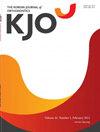非拔牙透明矫正器治疗成人前路开放性咬伤
IF 1.9
3区 医学
Q1 Dentistry
引用次数: 7
摘要
目的探讨透明矫正器治疗成人非拔牙患者前牙开咬的疗效及机制。方法将69例成人前牙开咬患者分为Angle氏ⅰ、ⅱ、ⅲ类。50例患者出现骨开咬(下颌平面角[MPA]≥38°),19例患者出现牙开咬。在治疗前(T1)和治疗后(T2)确定了15个头颅测量标志。计算了门牙和磨牙的计划运动和实际运动的幅度。结果94%的患者复合阳性,平均最终复合1.1±0.8 mm。复咬合的平均变化为3.3±1.4 mm。仅使用透明矫正器时,上颌磨牙内嵌量为0.36±0.58 mm。与I类组比较,II类组上颌磨牙侵入量更大,MPA降低幅度更大。III类组表现出较大的下颌切牙挤压,但没有明显的垂直骨骼变化。结论在成人非拔牙病例中,使用矫正器矫正轻、中度前牙开咬可有效控制牙体垂直尺寸。III类患者的治疗机制与I类和II类患者有显著差异。牙齿开放咬合患者上颌切牙挤压和骨骼开放咬合患者下颌切牙挤压降低MPA是开放咬合最重要的影响因素。本文章由计算机程序翻译,如有差异,请以英文原文为准。
Treatment of anterior open bites using non-extraction clear aligner therapy in adult patients
Objective The purpose of this study was to examine the effectiveness and mechanism of clear aligner therapy for the correction of anterior open bite in adult nonextraction cases. Methods Sixty-nine adult patients with anterior open bite were enrolled and classified into Angle’s Class I, II, and III groups. Fifty patients presented with skeletal open bite (mandibular plane angle [MPA] ≥ 38°), whereas 19 presented with dental open bite. Fifteen cephalometric landmarks were identified before (T1) and after (T2) treatment. The magnitudes of planned and actual movements of the incisors and molars were calculated. Results Positive overbite was achieved in 94% patients, with a mean final overbite of 1.1 ± 0.8 mm. The mean change in overbite was 3.3 ± 1.4 mm. With clear aligners alone, 0.36 ± 0.58 mm of maxillary molar intrusion was achieved. Compared with the Class I group, the Class II group showed greater maxillary molar intrusion and MPA reduction. The Class III group showed greater mandibular incisor extrusion with no significant vertical skeletal changes. Conclusions Clear aligners can be effective in controlling the vertical dimension and correcting mild to moderate anterior open bite in adult nonextraction cases. The treatment mechanism for Class III patients significantly differed from that for Class I and Class II patients. Maxillary incisor extrusion in patients with dental open bite and MPA reduction with mandibular incisor extrusion in patients with skeletal open bite are the most significant contributing factors for open bite closure.
求助全文
通过发布文献求助,成功后即可免费获取论文全文。
去求助
来源期刊

Korean Journal of Orthodontics
Dentistry-Orthodontics
CiteScore
2.60
自引率
10.50%
发文量
48
审稿时长
3 months
期刊介绍:
The Korean Journal of Orthodontics (KJO) is an international, open access, peer reviewed journal published in January, March, May, July, September, and November each year. It was first launched in 1970 and, as the official scientific publication of Korean Association of Orthodontists, KJO aims to publish high quality clinical and scientific original research papers in all areas related to orthodontics and dentofacial orthopedics. Specifically, its interest focuses on evidence-based investigations of contemporary diagnostic procedures and treatment techniques, expanding to significant clinical reports of diverse treatment approaches.
The scope of KJO covers all areas of orthodontics and dentofacial orthopedics including successful diagnostic procedures and treatment planning, growth and development of the face and its clinical implications, appliance designs, biomechanics, TMJ disorders and adult treatment. Specifically, its latest interest focuses on skeletal anchorage devices, orthodontic appliance and biomaterials, 3 dimensional imaging techniques utilized for dentofacial diagnosis and treatment planning, and orthognathic surgery to correct skeletal disharmony in association of orthodontic treatment.
 求助内容:
求助内容: 应助结果提醒方式:
应助结果提醒方式:


